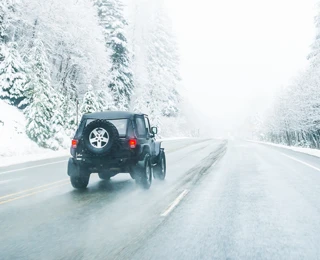Are All-Season or All-Weather Tires Okay in the Snow?
All tires are purpose-built, from the tread design to the sidewall. Even the type of tread compound makes a big difference. Here’s how to understand the difference between all-season and winter tires, and what kind you need to safely navigate the rain, snow, ice, and freezing temperatures.
All-Season vs. Winter vs. All-Weather Tires
Each type of tire offers specific advantages depending on your driving needs.
What Are All Season Tires?
All-season tires are designed for a smooth, quiet ride in most conditions. Many all-season tires do great in the rain and bare pavement year-round. While a set of all-season tires can offer some traction in light snow and the occasional winter storm, they’re not designed for deep snow, ice, and cold weather (when temperatures stay below ~45º F).
What Are All-Weather Tires?
All-weather tires that earn the 3-Peak Mountain Snowflake (3PMSF) designation offer winter-driving capabilities along with capable performance in all seasons. Instead of changing your tires twice a year (from summer to winter tires and vice-versa), all-weather tires handle great in the summer and offer better grip than standard all-season tires in winter driving conditions. However, all-weather tires might not be as quiet as all-season tires and may not last as long.
What Are Snow Tires?
Winter or snow tires are designed for prolonged winter conditions, including snow, ice, and slush. The tread compounds in those tires stay softer and more flexible in cold weather. This improves traction, handling, and control when temperatures dip below ~45º F. Additionally, the biting edges of the deep, wide, and jagged tread on snow tires maintain traction in the harshest conditions. A winter tire that includes studs can add even more traction when driving on icy roads.
ALL-SEASON
TIRES
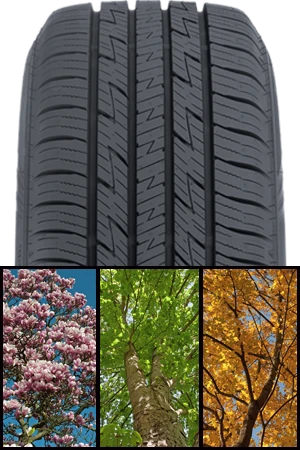
ROAD CONDITIONS: Rain, dry, some light snow ~45ºF and up.
TREAD: Shallower grooves offer comfort and control in most road conditions.
RUBBER COMPOUND: Rubber compound performs best above ~45ºF, and is designed for longer tread life.
SIPING: Siping in all-season tires helps provide traction in light snow.
All-WEATHER
TIRES
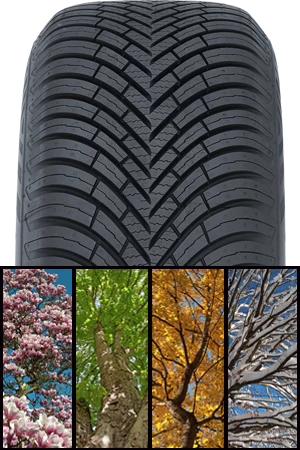
ROAD CONDITIONS: Rain, dry, snow above freezing temperatures.
TREAD: More aggressive than all-season but less than a dedicated winter tire. Wider grooves help move water to avoid hydroplaning.
RUBBER COMPOUND: Rubber compound remains flexible at or above freezing temperatures.
SIPING: Center sipes give added grip in the snow.
WINTER/SNOW
TIRES
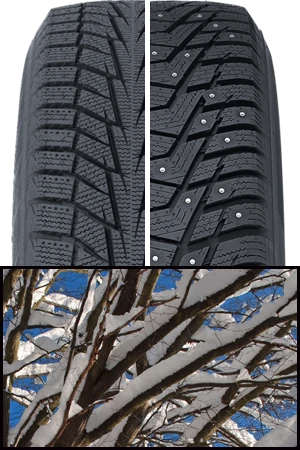
ROAD CONDITIONS: Snow, ice, rain, and slush ~45ºF and below.
TREAD: Deep, wide, jagged tread offers better traction in winter road conditions.
RUBBER COMPOUND: Rubber compound stays soft and flexible in cold weather to help with grip.
SIPING: Winter tires will typically have more siping to maximize grip in winter driving conditions.
Deciding What Tire Is Right for You
Every type of tire has its advantages and trade-offs. If you want a dedicated set of winter tires, you’ll need to change them out every spring and fall to get the most life out of your investment. That means you’ll need a set of all-season or summer tires the rest of the year. Those all-season tires might perform well year round, but they do lose some traction in colder temperatures and icy conditions.
Running out of space in the garage for a full set of tires and/or wheels? Les Schwab can help with special storage options.
Want to stick with one set of tires all year long? All-weather tires make it possible. While they do give you better traction in the snow and ice than all-seasons, they do not perform as well in the winter as a set of snow tires, nor do they handle as well as a set of all-season tires on wet and dry roads. Plus, a set of all-season tires can often be quieter and improve fuel efficiency or range.
The right tires for your vehicle and driving needs are at Les Schwab. Our pros can help you choose the right snow tires, electric vehicle (EV) tires, as well as all-season or all-weather tires for year-round safety.
Stopping and Control Are Important
When you’re on bare or wet pavement, the right set of all-season tires is designed to keep you safely on the road. They even do okay in mild winter conditions. But when the weather worsens and roads are covered in ice and snow, having the right set of winter or snow tires can help you stay in control of your vehicle. That includes stopping.
Think about it this way, when going on a long hike, a pair of hiking shoes will help you traverse almost any terrain. Even some snow. But when you get to packed snow and ice, snowshoes are the only way to go. They’re designed for winter conditions.
Match Tread Pattern & Depth to Your Needs
The tread, including the rubber compound as well as depth and pattern on a set of tires can tell you a lot about what they were designed to do. Understanding those features can help you match your needs with the right set of tires.
Rubber:
Winter tires are made with a special rubber compound that stays flexible in temperatures below 45º F. This means those tires can grip the snow and road better. In contrast, all-season tires can become rigid in colder temperatures, reducing grip on the road. All-weather tires stay flexible at lower temperatures, but not as low as winter tires.
Depth:
Winter tires often have a much deeper tread than all-season or all-weather tires. This helps snow tires reduce snow buildup and moves slush and water away from the tire, giving you more traction. All-season and all-weather tires feature moderate tread depth and sipes for dry and wet road performance and to help avoid hydroplaning. Some all-weather tires have more tread depth than the typical all-season tire to help with traction on snow and ice.
Patterns:
The tread patterns on today’s innovative tires are there for added safety and performance. Winter tire patterns are more rugged. This helps move snow and slush. All-season and all-weather tire patterns are more uniform to give you more control on wet and dry roads.
Edges
All-season tires typically do not have aggressive or biting edges for added control on snow-covered roads. However, winter tires as well as some all-weather tires do feature tread with biting edges. This gives them a more aggressive look and added performance on snow and ice.
Consider Safety & Performance:
Every set of tires offers specific traction and performance benefits. These positives boil down to the following:
All-season tires are great for year-round driving on wet and dry roads in climates that remain at or above 45º F.
All-weather tires combine the best features of a snow tire and all-season tire. This means they give you more traction in the snow and ice than all-seasons, but not as much added safety as a set of snow tires. Additionally, they do not perform as well as a set of all-season tires in the warmer months.
Winter tires are essential when it comes to driving in the snow and ice. Plus, they remain flexible in freezing conditions. Even if the road is dry, those snow tires will still grip the road.
Understand Legal Requirements
States throughout the West have different requirements for the use of studded and studless winter tires. Find your state’s information here. Additionally, a set of chains that fit your vehicle can help keep you safely on the road when conditions worsen.
Should You Own a Set of Winter Tires?
Installing a set of snow tires on your vehicle from late fall to early spring can be a good idea. Especially if you’re going to the mountains every weekend or your town gets hit hard by winter weather and stays at or near freezing for months at a time.
Our Best Rated All-Season & All-Weather Tires for Snow
-
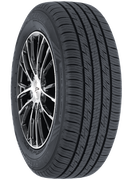
- All-Season
- Reputation
-
-
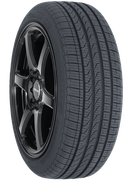
- All-Season
- Cinturato P7 All Season
-
- Run-Flat
-
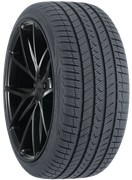
- All-Weather
- Quatrac Pro
-
- Severe Weather Rated
Get Your Winter Tires (and advice) at Les Schwab
Your local Les Schwab can help you decide on the right set of tires for your needs, including snow tires, all-season tires, all-weather tires, and more.
What you need to know

Summer Tires vs All-Season Tires: Which Are Best for You?
Let us help you understand the differences between summer, all-season, and performance tires and decide which gets you better traction and performance.
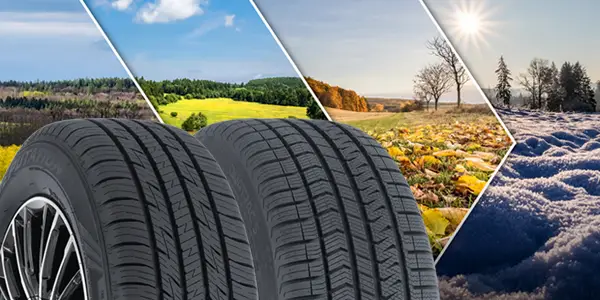
When to Choose All-Season or All-Weather Tires
Learn when to choose all-season or all-weather tires. Understand performance, climate suitability, and driving needs to make the best choice for your vehicle.

When to Choose All-Terrain Tires or All-Weather Tires
Wondering what the difference between all-terrain and all-weather tires is? Read this article to find out the key differences, and which tire suits you best.

